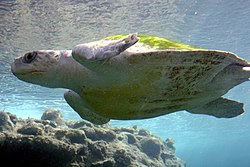Cheloniidae
Appearance
| Cheloniid sea turtles | |
|---|---|

| |
| A green sea turtle, a species of the family Cheloniidae, swimming over coral reefs in Kona, Hawaii | |
| Scientific classification | |
| Domain: | Eukaryota |
| Kingdom: | Animalia |
| Phylum: | Chordata |
| Class: | Reptilia |
| Order: | Testudines |
| Suborder: | Cryptodira |
| Superfamily: | Chelonioidea |
| Family: | Cheloniidae Oppel, 1811[1] |
| Type species | |
| Testudo mydas Linnaeus, 1758
| |
| Synonyms[1] | |
| |
The Cheloniidae are a family of sea turtles belonging to the sea turtle superfamily Chelonioidea. It was named by Nicolaus Michael Oppel in 1811.[1]
Classification
Extant genera
- Subfamily Carettinae
- Genus Caretta
- Loggerhead sea turtle (Caretta caretta)[1]
- Genus Lepidochelys
- Kemp's ridley sea turtle (Lepidochelys kempii)[1]
- Olive ridley sea turtle (Lepidochelys olivacea)[1]
- Genus Caretta
- Subfamily Cheloniinae
- Genus Chelonia
- Green sea turtle (Chelonia mydas)[1]
- Genus Eretmochelys
- Hawksbill sea turtle (Eretmochelys imbricata)[1]
- Genus Natator
- Flatback sea turtle (Natator depressus)[1] (previously in Chelonia)
- Genus Chelonia
Cladogram
Below is a cladogram showing the phylogenetic relationships of living and extinct sea turtles in the family Cheloniidae based on Lynch and Parham (2003)[2] and Parham and Pyenson (2010).[3]
| Pancheloniidae (=Cheloniidae sensu lato) |
| ||||||
References
- ^ a b c d e f g h i Rhodin 2011, p. 000.172
- ^ Lynch, S.C.; Parham, J.F. (2003). "The first report of hard-shelled sea turtles (Cheloniidae sensu lato) from the Miocene of California, including a new species (Euclastes hutchisoni) with unusually plesiomorphic characters" (PDF). PaleoBios. 23 (3): 21–35.
- ^ James F. Parham; Nicholas D. Pyenson (2010). "New Sea Turtle from the Miocene of Peru and the Iterative Evolution of Feeding Ecomorphologies since the Cretaceous". Journal of Paleontology. 84 (2): 231–247. doi:10.1666/09-077R.1.
{{cite journal}}: CS1 maint: multiple names: authors list (link)
External links
- Skaphandrus.com Cheloniidae
Bibliography
- Rhodin, Anders G.J.; van Dijk, Peter Paul; Inverson, John B.; Shaffer, H. Bradley; Roger, Bour (2011-12-31). "Turtles of the world, 2011 update: Annotated checklist of taxonomy, synonymy, distribution and conservation status". Chelonian Research Monographs. 5. Archived from the original (PDF) on 2012-01-22.
{{cite journal}}: CS1 maint: multiple names: authors list (link)

